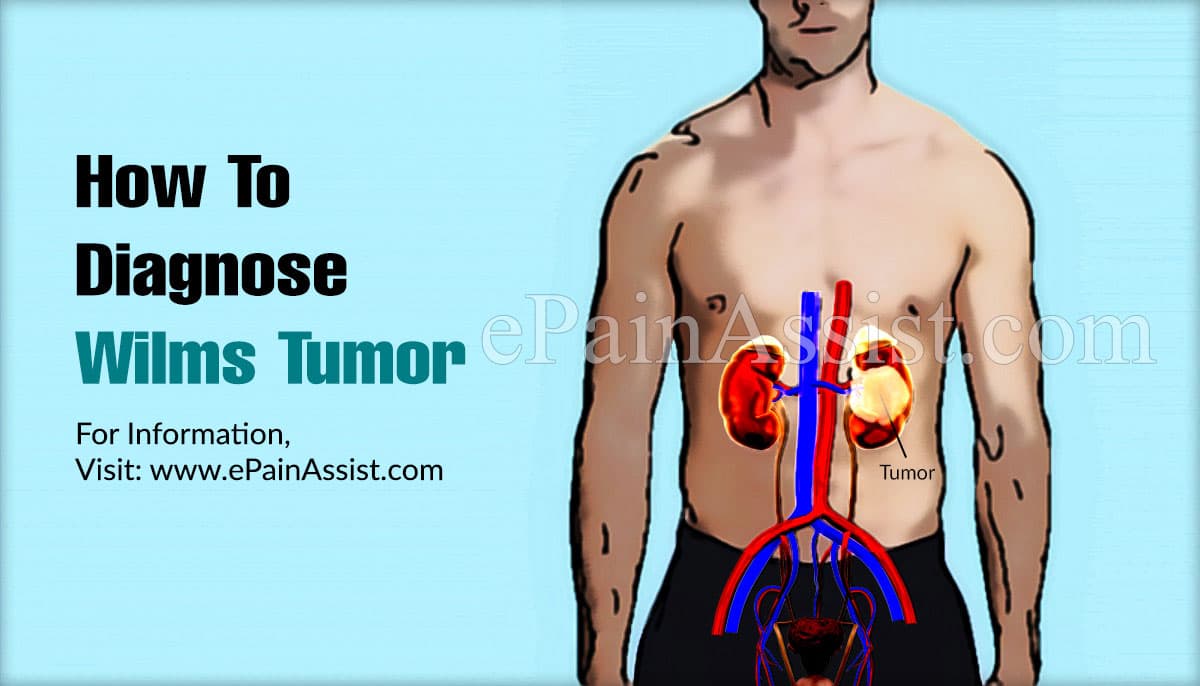Wilms tumor is a form of cancer in the kidneys that affects children. In children, it’s the most prevalent form of cancer of the kidney. Histologically Wilms tumor can be classified into two groups: Favorable histology and Anaplastic histology 1. In favorable histology, the cancer cells do not show anaplasia, but they can be differentiated from normal cells. In anaplastic histology, the cancerous cells contain distorted and large nucleus known as anaplasia. The appearance of cancer cells in these tumors differs extensively. Anaplasia may be focal (restricted to some tumor sections) or diffuse (distributed all over the tumor). Favorable histology is more common (90% of Wilms tumor cases have favorable histology) and has a better chance of complete healing 2.

How To Diagnose Wilms Tumor?
There are several steps in the diagnosis of Wilms tumor. The doctor may suggest:
- A physical examination where the physician will observe for the classic symptoms of Wilms tumor.
- Urine and blood examinations to find the condition of your child’s kidney, its functionality, definite issues, and the possibility of low blood counts.
- Imaging tests (MRI, CT, and Ultrasound) can detect the presence of tumors in the kidneys.

What Is The Best Medicine For Wilms Tumor?
Wilms tumor treatment depends on the disease stages as well as histology of the cancer cells and generally includes chemotherapy and surgery with occasional radiation therapy 3. The treatment usually takes place in a specialized cancer center for children. Treatment also takes into consideration the following factors:
The Tumor Size: Whether the Wilms tumor has any changes in the chromosome
The Age Of The Patient: Surgery is the preferred mode of treatment followed by chemotherapy in the United States. However, in Europe doctors prefer administering chemotherapy first and then opt for surgery. Both the treatment protocols yield similar outcomes 4.
Usually, the histology and stage of the disease can be accurately determined during the surgery as imaging tests often cannot determine the real magnitude of cancer. Sometimes it is evident from the imaging exams that cancerous cells have spread outside the kidney. This can influence the sequence of treatment and the process of surgery 4.
The Surgical Intervention In Wilms Tumor May Include:
Removal Of Some Parts Of The Patient’s Affected Kidney: This is done when the Wilms tumor is small and affects only one of the two kidneys and the patient survives on the other functional kidney.
Removal Of The Whole Kidney And Adjacent Tissues: One of the patient’s kidneys is completely removed along with surrounding lymph nodes, ureter, and the adrenal gland. This is also done when only one of the patient’s kidneys has cancer. The second kidney of the patient remains functional and devoid of cancer.
Removal Of Both The Kidneys And Parts Of Them: This is done when both kidneys are affected by cancer. The patient survives through dialysis and possible kidney transplant.
After surgery, the tissues are sent to a laboratory to confirm the presence of cancer cells 5.
Chemotherapy: Chemotherapy treatment involves the use of strong medicines to kill cells of cancer in the entire body. Usually, a combination of drugs is given through intravenous route 6.
Radiation Therapy: Radiation therapy can be suggested based on the tumor stage where high-energy radiation is used to neutralize cancer cells 6.
Clinical Trials: The doctor treating your child may advise taking part in clinical trials, which allows your child to have an opportunity to have the newest therapies; however, they can’t ensure a cure 6.
Common Symptoms Of Wilms Tumor
Most Wilms tumor patients experience some common clinical symptoms, including the presence of an abdominal mass with abdominal pain and swelling. There may be additional symptoms such as:
- Presence of blood in the urine
- Constipation
- Fever
- High blood pressure
- Loss of appetite
- Nausea and vomiting
- Shortness of breath
Conclusion
Wilms tumor treatment represents one of the most successful cancer therapies with a 90% success rate using modern medication. The current focus is on decreasing the side effects and toxicity of the chemotherapeutic drugs. Most of the Wilms tumor patients survive long-term, irrespective of the therapeutic sequence and interventions. Despite this achievement, the modern treatments are still suboptimal for 25% of the patients having recurrently favorable, bilateral or anaplastic histologic characteristics. This emphasizes the necessity of ongoing efforts to develop new avenues for treatment.
- Lowe LH, Isuani BH, Heller RM, et al. Pediatric renal masses: Wilms tumor and beyond. Radiographics. 2000;20(6):1585-1603.
- McDougal WS, Wein AJ, Kavoussi LR, Partin AW, Peters CA. Campbell-Walsh Urology 11th Edition Review E-Book. Elsevier Health Sciences; 2015.
- Metzger ML, Dome JS. Current therapy for Wilms’ tumor. The oncologist. 2005;10(10):815-826.
- Dome JS, Cotton CA, Perlman EJ, et al. Treatment of anaplastic histology Wilms’ tumor: results from the fifth National Wilms’ Tumor Study. J Clin Oncol. 2006;24(15):2352-2358.
- Kieran K, Ehrlich PF. Current surgical standards of care in Wilms tumor. Paper presented at: Urologic Oncology: Seminars and Original Investigations2016.
- Cost NG, Lubahn JD, Granberg CF, et al. Oncologic outcomes of partial versus radical nephrectomy for unilateral Wilms tumor. Pediatric blood & cancer. 2012;58(6):898-904.
Also Read:
- What Are The Stages Of Wilms Tumor & What Is The Survival Rate?
- What Leads To Wilms Tumor & Can It Be Cured?
- What Is The Prognosis For Wilms Tumor?
- Lifestyle Changes For Wilms Tumor
- Who Is At Risk For Wilms Tumor & Is There A Blood Test For It?
- How Does Wilms Tumor Causes Hypertension?
- Is Wilms Tumor Congenital?
